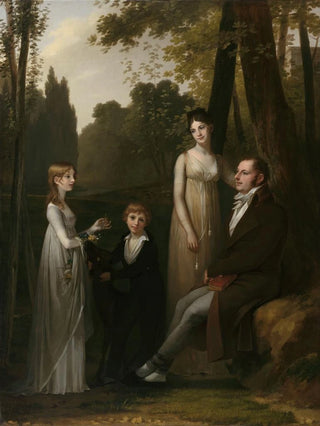Art print | Portrait of Rutger Jan Schimmelpenninck and his family - Pierre-Paul Prud'hon


View from behind

Frame (optional)
In the fascinating world of art, some works stand out for their ability to capture not only appearance but also the very essence of their subjects. This is the case of the "Portrait of Rutger Jan Schimmelpenninck and his family" created by Pierre-Paul Prud'hon. This piece, which transcends mere conventions of portraiture, invites the viewer into an intimate immersion into the early 19th-century French bourgeoisie. Through this painting, Prud'hon offers us a window into a bygone era, a family, and emotions that still resonate today. Every detail, every expression, seems charged with meaning, prompting us to reflect on family relationships and the values of the time.
Style and uniqueness of the work
Prud'hon's style is characterized by delicacy and harmony of forms that are uniquely his own. In this portrait, he employs a soft, nuanced palette, creating an atmosphere that is both warm and introspective. The composition is skillfully orchestrated, with each family member arranged to create visual balance while highlighting the bonds that unite them. The faces are treated with particular attention, revealing subtle expressions that testify to the psychology of the characters. This work is not merely a portrait; it becomes a true visual narrative, where each exchanged look and every gesture serve as clues to the family dynamics. Prud'hon thus succeeds in transcending the genre of portraiture by offering a lively and emotive representation of his subjects.
The artist and his influence
Pierre-Paul Prud'hon, an emblematic figure of Neoclassicism, mastered the combination of classical formality with romantic sensitivity. His work is marked by a constant pursuit of harmony and beauty, qualities that earned him international recognition. Prud'hon established himself in a rapidly changing artistic world, influencing many artists who followed him. His innovative approach to portraiture, where emotion and psychology take precedence over simple representation, paved the way for new artistic explorations. By depicting characters in authentic moments of life, he contributed to

Matte finish

View from behind

Frame (optional)
In the fascinating world of art, some works stand out for their ability to capture not only appearance but also the very essence of their subjects. This is the case of the "Portrait of Rutger Jan Schimmelpenninck and his family" created by Pierre-Paul Prud'hon. This piece, which transcends mere conventions of portraiture, invites the viewer into an intimate immersion into the early 19th-century French bourgeoisie. Through this painting, Prud'hon offers us a window into a bygone era, a family, and emotions that still resonate today. Every detail, every expression, seems charged with meaning, prompting us to reflect on family relationships and the values of the time.
Style and uniqueness of the work
Prud'hon's style is characterized by delicacy and harmony of forms that are uniquely his own. In this portrait, he employs a soft, nuanced palette, creating an atmosphere that is both warm and introspective. The composition is skillfully orchestrated, with each family member arranged to create visual balance while highlighting the bonds that unite them. The faces are treated with particular attention, revealing subtle expressions that testify to the psychology of the characters. This work is not merely a portrait; it becomes a true visual narrative, where each exchanged look and every gesture serve as clues to the family dynamics. Prud'hon thus succeeds in transcending the genre of portraiture by offering a lively and emotive representation of his subjects.
The artist and his influence
Pierre-Paul Prud'hon, an emblematic figure of Neoclassicism, mastered the combination of classical formality with romantic sensitivity. His work is marked by a constant pursuit of harmony and beauty, qualities that earned him international recognition. Prud'hon established himself in a rapidly changing artistic world, influencing many artists who followed him. His innovative approach to portraiture, where emotion and psychology take precedence over simple representation, paved the way for new artistic explorations. By depicting characters in authentic moments of life, he contributed to






